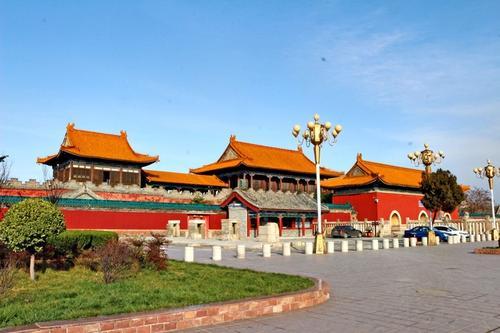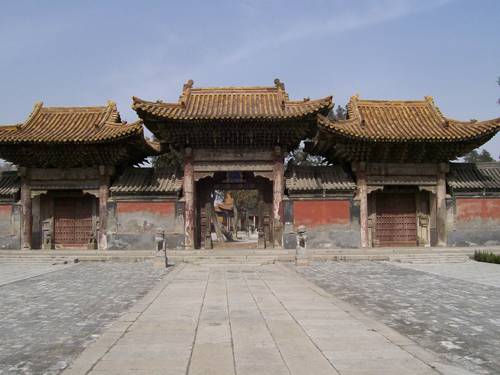Tang Xuanzong Imperial Stele
'The First Stele Under Heaven'—The remnant stele of 'Tang Xuanzong's Imperial Inscription on Mount Hua', commonly known as 'Five Sacred Mountains Stone'. It was personally written and inscribed by Emperor Tang Xuanzong Li Longji, hence also called the Imperial Stele. The stele originally had a protective pavilion, but it was destroyed by the Huang Chao rebel army in the first year of the Guangming era of the Tang Dynasty, leaving only scattered stone fragments that bear witness to the vicissitudes of history.
Wanshou Pavilion
Wanshou Pavilion is located at the center of the northern city wall. It is the tallest pavilion within the Xiyue Temple, featuring four-sided corridors and upturned eaves. The pavilion has three floors, with the highest being the Wanghe Pavilion. There are two other pavilions with double-eaved hip roofs to the north and south, each two stories high, connected to Wanshou Pavilion by a flying corridor with a rolled-up roof. The structure is majestic and imposing, reaching towards the sky. Climbing to the third floor of Wanshou Pavilion offers a panoramic view of Mount Hua, making it an excellent spot for capturing the full scenery of the mountain. The wide field of vision provides a commanding view of the landscape, with each frame resembling a historical epic.
Bei Zhou Stele
The treasure of the Xiyue Temple: the Xiyue Huashan Temple Stele. This stele was carved in 567 AD and is currently the most well-preserved millennium-old stele in the Xiyue Temple, with a history of over 1400 years. As early as the Tang Dynasty, it was regarded as a treasure by the Tang people. The Xiyue Temple is now a national precious cultural relic and has been listed as a famous stele prohibited from rubbing in China. This stele has a significant background: it is the only surviving work of the calligrapher Zhao Wenyuan, one of the three well-preserved steles, and it bears an inscription from the 'Biography of Yan Zhenqing' by one of the 'Four Great Masters of Regular Script'. What does it say? Come and see for yourself.
Lingxing Gate
It is the third gate of the Xiyue Temple, with a main structure that is three stories high, featuring a single-eaved Xieshan roof made of glazed tiles and supported by four large stone pillars. Each gate tower is modeled after the palace gates of the Ming and Qing dynasties, varying in size and adorned with vibrant colors. The intricate dougong (bracket sets) and dragon heads on the eaves showcase the complete palace style of the Xiyue Temple, reflecting the respect that emperors of various dynasties had for the temple.
Haoling Hall
Located at the center of the temple, it is the main building of the Xiyue Temple and the place where emperors and imperial envoys held public sacrifices throughout history. In the middle of the main entrance hangs a golden plaque inscribed with 'Haoling Hall'. Inside the hall, there is a tablet dedicated to the 'God of Mount Hua of the Western Yue'. Additionally, there are three golden plaques with dragon patterns inscribed by Emperor Tongzhi of the Qing Dynasty ('Rui Ning Xian Zhang'), Empress Dowager Cixi ('Xian Zhang'), and Emperor Guangxu ('Jin Tian Zhao Rui').













